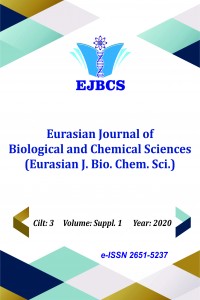Removal of Methyl Red from Aqueous Solutıons with Natural and Biochar Prina: A Full Factorial Modeling Study
Abstract
Wastewater from various industries contains a high concentration of dyes. Dyeing wastewater discharged into natural receiving waters without treatment; they are dangerous for both of the environment and human health.Therefore, it is necessary to remove the dyes before it is discharged to the receiving environment. In this study, full factorial modeling of methyl red removal was studied by using adsorption method which is widely used in dye removal with natural and modified prina adsorbent. 23 factorial design is used in the modeling method. In there 3 factors; adsorbent content (0.03g/30mL - 0.3g/30mL), initial dye concentration (30mg/L - 300mg/L) and adsorbent type (natural and biochar pomace) were selected. These factors were studied in two low (-1) and high (+1) levels. Effects of selected factors on adsorption efficiency; adsorbent type > initial concentration> adsorbent dosage. In addition, removal efficiencies up to 88% were obtained with biochar prina and it was found that prina is a good alternative adsorbent for methyl red removal.
Keywords
Supporting Institution
-
Project Number
-
Thanks
-
References
- Ai M, Yang G, Zhang R. 2006. Minimum aberration blocking of regular mixed factorial designs. J. Stat. Plan. Inference 136:1493–1511.
- Erbaş O, Semra OH. 2006. Experimental Schemes and Statistical Analysis. Gazi Bokstore, pp 62-65.
- Iram M, Guo C, Guan Y, Ishfag A, Liu H. 2010. Adsorption and magnetic removal of neutral red dye from aqueous solution using Fe3O4 hollow nanospheres. J. Hazard. Mater. 181:1039-1050.
- Jaikumar V, Ramamurthi V. 2009. Statistical analysisi and optimization of acid dye biosorption by brewery waste biomass using response surface methodology. Modern Appl. Sci. 4:71-84.
- Köse TE. 2008. Agricultural residue anion exchanger for removal of dyestuff from wastewater using full factorial design. Desalination, 222: 323-330.
- Lian L, Guo L, Wang A. 2009. Use of CaCl2 modified bentonite for removal of Congo red dye from aqueous solutions, Desalination, 249: 797-801.
- Luo P, Zhao Y, Zhang B, Liu J, Yang Y, Liu J. 2010. Study on the adsorption of Neutral Red dye from aqueous solution onto halloysite nanotubes. Water Res. 44:1489-1497.
- Montgomery D, Runger G, Hubele N. 2001. Engineering Statistics. John Wiley & Sons, New York, 2:24-28.
- Şenoğlu B, Acıtaş Ş. 2014. Statistical Experiment Design Fixed Effect Models. Nobel, pp 12-19.
- Tibet, Y, Çoruh S. 2017. Immobilisation and leaching performance of lead-acid batteries smelting slag using natural and waste materials. Glob. NEST J. 19:562–573.
- Yin Y, Zhou J. 2015. Minimax design criterion for fractional factorial designs. Ann. Inst. Stat. Math. 67:673–685.
- Zhao S, Chen X. 2012. Mixed two-and four-level fractional factorial split-plot designs with clear effects. J. Stat. Plan. Inference 142:1789–1793.
Abstract
Project Number
-
References
- Ai M, Yang G, Zhang R. 2006. Minimum aberration blocking of regular mixed factorial designs. J. Stat. Plan. Inference 136:1493–1511.
- Erbaş O, Semra OH. 2006. Experimental Schemes and Statistical Analysis. Gazi Bokstore, pp 62-65.
- Iram M, Guo C, Guan Y, Ishfag A, Liu H. 2010. Adsorption and magnetic removal of neutral red dye from aqueous solution using Fe3O4 hollow nanospheres. J. Hazard. Mater. 181:1039-1050.
- Jaikumar V, Ramamurthi V. 2009. Statistical analysisi and optimization of acid dye biosorption by brewery waste biomass using response surface methodology. Modern Appl. Sci. 4:71-84.
- Köse TE. 2008. Agricultural residue anion exchanger for removal of dyestuff from wastewater using full factorial design. Desalination, 222: 323-330.
- Lian L, Guo L, Wang A. 2009. Use of CaCl2 modified bentonite for removal of Congo red dye from aqueous solutions, Desalination, 249: 797-801.
- Luo P, Zhao Y, Zhang B, Liu J, Yang Y, Liu J. 2010. Study on the adsorption of Neutral Red dye from aqueous solution onto halloysite nanotubes. Water Res. 44:1489-1497.
- Montgomery D, Runger G, Hubele N. 2001. Engineering Statistics. John Wiley & Sons, New York, 2:24-28.
- Şenoğlu B, Acıtaş Ş. 2014. Statistical Experiment Design Fixed Effect Models. Nobel, pp 12-19.
- Tibet, Y, Çoruh S. 2017. Immobilisation and leaching performance of lead-acid batteries smelting slag using natural and waste materials. Glob. NEST J. 19:562–573.
- Yin Y, Zhou J. 2015. Minimax design criterion for fractional factorial designs. Ann. Inst. Stat. Math. 67:673–685.
- Zhao S, Chen X. 2012. Mixed two-and four-level fractional factorial split-plot designs with clear effects. J. Stat. Plan. Inference 142:1789–1793.
Details
| Primary Language | English |
|---|---|
| Subjects | Environmental Engineering |
| Journal Section | Research Articles |
| Authors | |
| Project Number | - |
| Publication Date | December 31, 2020 |
| Acceptance Date | December 25, 2020 |
| Published in Issue | Year 2020 Volume: 3 Issue: (Suppl 1) |
Cite


